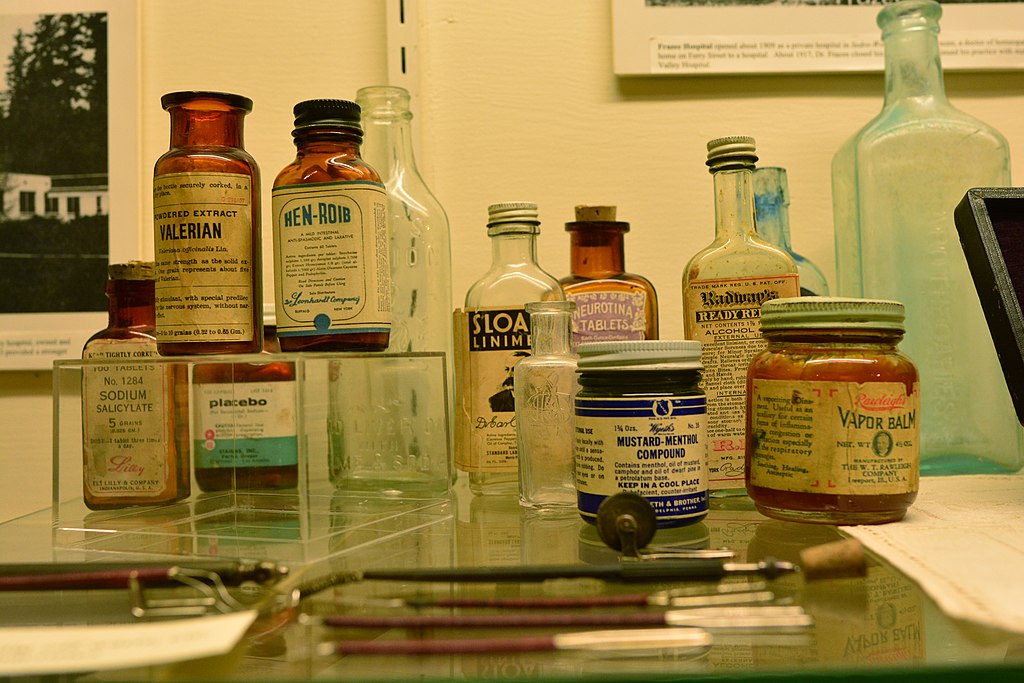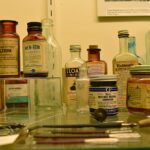 Joe Mabel, CC BY-SA 3.0 , via Wikimedia Commons
Joe Mabel, CC BY-SA 3.0 , via Wikimedia CommonsMedicine hasn’t always been the clean, science-backed practice it is today. In fact, some of the remedies that were once considered cutting-edge would make your stomach turn—or send you straight to the grave. From mercury to arsenic to radioactive tonics, many historical treatments were based on theories that hadn’t been properly tested, or were rooted in guesswork and tradition. People trusted these concoctions because they were promoted by respected physicians or sold in chemists without prescription. But behind the grand claims were ingredients that could cause slow, painful deaths. Here are some of the most alarming examples of medicines that contained actual poison—and were given to people in full confidence that they would help.
Mercury for everything from syphilis to teething
Mercury was once a medical marvel—or so it seemed. It was used for centuries, particularly to treat syphilis, long before antibiotics existed. Patients were encouraged to inhale mercury vapour, rub mercury ointments into their skin, or even ingest it. The idea was that it would purge the body of disease through sweating, salivating, or diarrhoea. The phrase “a night with Venus, a lifetime with Mercury” summed up the grim reality of a treatment that was often worse than the illness itself.
Mercury was also found in powders and teething aids for babies. Known as “calomel,” these mercury compounds were marketed as safe remedies for irritability and digestive issues. Some parents even used it as a laxative or to soothe teething pain. In reality, it caused neurological damage, tooth loss, and in extreme cases, death. By the early 20th century, medical authorities began to raise alarms about mercury’s toxicity, but it still took years for these products to vanish from shelves.
Arsenic as a beauty tonic and stimulant
Yes, arsenic—the substance we now associate with poisonings and crime dramas—was once sold over the counter in tonics. It was marketed as a cure for anaemia, skin blemishes, and even low energy. In Victorian England, women would take small doses of arsenic to make their skin appear paler and more luminous, believing it gave them a porcelain-like complexion. The “arsenic wafer” became a household name.
What it actually did was slowly poison them. Regular consumption of arsenic could lead to vomiting, fatigue, liver damage, and ultimately organ failure. Still, products like Fowler’s Solution, an arsenic-based tonic, were available on prescription well into the 20th century. A 1909 article in the British Medical Journal even defended its use under strict dosage. The slow pace of regulation meant many people unknowingly paid the ultimate price for a beauty standard.
Lead in face creams, powders, and tonics
Lead has a long history in medicine and cosmetics, particularly in ancient Rome, where lead-based powders were used to whiten the skin. Wealthy Roman women applied lead paste to their faces daily, chasing the fashionable pallor that signalled nobility. The same practice resurfaced in the Georgian and Victorian eras, when women used lead-laced foundations and face creams to cover blemishes and appear more refined.
The results were devastating. Lead accumulates in the body, damaging the kidneys, brain, and nervous system. Prolonged exposure could cause blackened teeth, muscle weakness, cognitive impairment, and fertility issues. But beauty standards often outweighed safety concerns. Even when symptoms began to show, they were rarely traced back to the creams and powders causing them.
Radioactive water as a miracle cure
When radium was discovered in the late 19th century, it was met with awe. Its glowing properties and “life-giving” energy were hailed as miraculous. Before long, products like Radithor were being sold to the public as all-purpose energy tonics. Marketed with slogans like “perpetual sunshine,” these radioactive drinks were believed to treat everything from arthritis and depression to impotence and fatigue.
Perhaps the most infamous case was that of industrialist Eben Byers, who drank Radithor religiously. After consuming over 1,400 doses, he developed severe radiation poisoning, and parts of his jawbone disintegrated. He died in 1932, aged just 51. His case sparked a backlash and tighter safety regulations on radioactive products. The National Museum of American History details the horrifying legacy of these products and how they fuelled false hope.
Hemlock to calm the nerves
In ancient Greece, hemlock wasn’t just a method of execution—it was also used medicinally. Physicians prescribed small doses of the plant as a sedative and muscle relaxant, particularly in cases of severe anxiety or spastic conditions. Its effects were known, but often underestimated.
The danger, of course, was in the dosage. Hemlock contains coniine, a neurotoxin that affects the central nervous system. Even slightly too much could lead to respiratory paralysis and death. Socrates remains the most famous victim, drinking a fatal dose of hemlock as his form of execution. But many others may have suffered the same fate in smaller, accidental doses, mistakenly believing they were receiving relief.
Belladonna to brighten the eyes
Belladonna, or deadly nightshade, had a long-standing place in both medicine and beauty. During the Renaissance, women used eye drops made from the plant to dilate their pupils, a look that was considered seductive. The name “belladonna” literally means “beautiful woman” in Italian.
But the consequences were serious. Belladonna contains atropine, which affects the nervous system and can cause blurred vision, sensitivity to light, dry mouth, and hallucinations. In large doses, it’s fatal. Doctors also used belladonna to treat asthma and motion sickness, but with mixed and sometimes deadly results. The balance between beauty and poison was a dangerous tightrope.
Antimony as a digestive aid
Antimony, a metallic element, was used in various medical concoctions throughout the 17th and 18th centuries. One of the most infamous forms was the “everlasting pill”—a small tablet made of pure antimony. It was swallowed whole to provoke vomiting or purging, then retrieved from the chamber pot, cleaned, and reused by the same person or their family.
Though it certainly produced a laxative effect, the side effects could include stomach cramps, dehydration, and gradual poisoning. Over time, repeated use would lead to toxic build-up. Despite this, antimony-based remedies were endorsed by physicians who saw purging as a way of cleansing the body. Only with the rise of modern pharmacology did the dangers become too difficult to ignore.
Opium for children
Opium was once seen as a household staple for dealing with fussy children. It was a common ingredient in over-the-counter syrups and cordials sold for colic, coughs, teething pain, and diarrhoea. “Godfrey’s Cordial,” a mixture of opium, treacle, and spices, was widely available in Britain and used liberally by parents and carers.
While it certainly quieted children, the risks were horrific. Respiratory depression, addiction, and death were all documented outcomes. Working-class families, often lacking access to doctors, relied heavily on these syrups. It wasn’t until the Pharmacy Act of 1868 in the UK that opium began to be restricted, and even then, products continued to circulate through informal markets for decades.
Stramonium for asthma relief
Stramonium, also known as jimsonweed or thorn apple, was used to treat asthma by burning the dried leaves and inhaling the smoke. The idea was that the alkaloids would relax the bronchial muscles and open up the airways. At first, it seemed effective, and stramonium cigarettes were sold widely in the 19th and early 20th centuries.
But stramonium contains potent chemicals like atropine and scopolamine, which can cause hallucinations, delirium, and heart problems. Overdose was a very real risk, especially when users couldn’t control the dosage of smoke they inhaled. While it did have a bronchodilator effect, the dangers quickly outweighed the benefits, and the treatment was largely abandoned by the mid-20th century.
Many of these poisonous “cures” were given in good faith, based on the best understanding of the time.
However, they’re a stark reminder of how far medicine has come, and how dangerous it can be when treatments are accepted without rigorous testing. Today’s regulatory frameworks, drug trials, and pharmacovigilance might seem slow and frustrating, but they exist to protect lives. In hindsight, the toxic cocktails of the past offer a chilling perspective on how easily good intentions can lead to tragedy when science takes a backseat to speculation.



